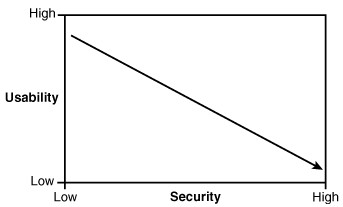Determining the Next Step
At this point in the project, you should take a moment to thank everyone who has been involved. It is important that all members of the team go their separate ways feeling as positive as possible, knowing that they helped contribute to the bettering of the overall security of the organization. It may be appropriate to hold a final meeting at which you thank everyone for their contributions and express enthusiasm that they all played a part in building a more secure organization. Based on the findings, some of these same individuals may be involved in implementing controls to improve security.
Finally, don't forget that trade-offs must sometimes be made between business objectives and security. Your job here is to make recommendations. Management is ultimately responsible for determining what is right. These trade-offs may not always be resolved in favor of security; management must make the decision to accept risk. For example, your findings might indicate that e-commerce activities put the organization at a greater risk of attack or denial-of-service. However, this may be weighed against data that indicates the organization may have a 60% growth in profit by doing business over the Web. Therefore, management may decide to accept the risk because there is such a high potential for added growth and revenue. In the end, there is always a trade-off between security and usability, as shown in Figure 9.2.
Figure 9.2. Security and usability trade-off.

Accidents, errors, and omissions account for much higher losses than deliberate acts. Some studies indicate that more than 60% of information losses are caused by accidents. Only 35 to 40% are deliberate acts. Of this percentage, most of this activity can be traced to internal sources. That's rightthe people you have the most to fear are those closest to you! Therefore, controls that reduce the potential for these harmful effects of insiders should always rank on your list of recommendations. Building good policies and policy enforcement mechanisms is critical. Security against deliberate acts can be achieved only if a potential perpetrator believes there is a definite probability of being detected.
Introduction to Assessing Network Vulnerabilities
- Introduction to Assessing Network Vulnerabilities
- What Security Is and Isnt
- Process for Assessing Risk
- Four Ways in Which You Can Respond to Risk
- Network Vulnerability Assessment
Foundations and Principles of Security
- Foundations and Principles of Security
- Basic Security Principles
- Security Requires Information Classification
- The Policy Framework
- The Role Authentication, Authorization, and Accountability Play in a Secure Organization
- Encryption
- Security and the Employee (Social Engineering)
Why Risk Assessment
- Why Risk Assessment
- Risk Terminology
- Laws, Mandates, and Regulations
- Risk Assessment Best Practices
- Understanding the IT Security Process
- The Goals and Objectives of a Risk Assessment
Risk-Assessment Methodologies
- Risk-Assessment Methodologies
- Risk-Assessment Terminology
- Quantitative and Qualitative Risk-Assessment Approaches
- Best Practices for Quantitative and Qualitative Risk Assessment
- Choosing the Best Risk-Assessment Approach
- Common Risk-Assessment Methodologies and Templates
Scoping the Project
- Scoping the Project
- Defining the Scope of the Assessment
- Reviewing Critical Systems and Information
- Compiling the Needed Documentation
- Making Sure You Are Ready to Begin
Understanding the Attacker
- Understanding the Attacker
- Who Are the Attackers?
- What Do Attackers Do?
- Reducing the Risk of an Attack
- How to Respond to an Attack
Performing the Assessment
- Performing the Assessment
- Introducing the Assessment Process
- Level I Assessments
- Level II Assessments
- Level III Assessments
Tools Used for Assessments and Evaluations
- Tools Used for Assessments and Evaluations
- A Brief History of Security Tools
- Putting Together a Toolkit
- Determining What Tools to Use
Preparing the Final Report
- Preparing the Final Report
- Preparing for Analysis
- Ranking Your Findings
- Building the Final Report
- Contents of a Good Report
- Determining the Next Step
- Audit and Compliance
Post-Assessment Activities
- Post-Assessment Activities
- IT Security Architecture and Framework
- Roles, Responsibilities, and Accountabilities
- Security Incident Response Team (SIRT)
- Vulnerability Management
- Training IT Staff and End Users
Appendix A. Security Assessment Resources
Appendix B. Security Assessment Forms
- Information Request Form
- Document Tracking Form
- Critical Systems and Information Forms
- Level II Assessment Forms
Appendix C. Security Assessment Sample Report
- Appendix C. Security Assessment Sample Report
- Notice
- Executive Summary
- Statement of Work
- Analysis
- Recommendations
- Conclusions
Appendix D. Dealing with Consultants and Outside Vendors
- Appendix D. Dealing with Consultants and Outside Vendors
- Procurement Terminology
- Typical RFP Procurement Steps
- Procurement Best Practices
Appendix E. SIRT Team Report Format Template
EAN: 2147483647
Pages: 138
